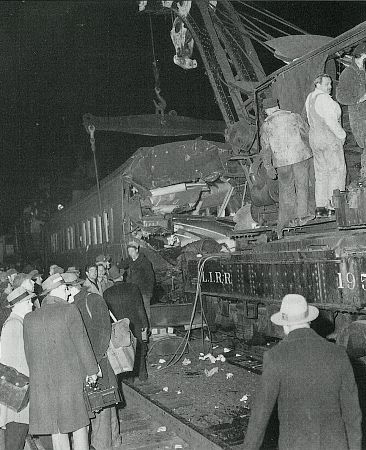
[The following is excerpted from the Richmond Hill Historical Society web page about the crash.] Click here to return to the main page. About the Long Island Railroad's Worst Train Crash Those who survived offered anguished accounts. Harold Rosenberg, 34, was riding in the last car of the Hempstead train. "I saw a terrific red flash and felt a jolt like an atom bomb," he told a reporter. He fell to the floor. He was bleeding from the mouth and nose. "People were lying all about, screaming in pain," Rosenberg said. "Others beat frantically at doors and windows, which were jammed shut. Seconds later, neighbors from across the way arrived at the scene with ladders and jimmied open the doors and started to take out the injured." Arthur Kearney, 28, a tax analyst, said the crash came seconds after the conductor on the Hempstead train signaled the train was ready to go if Murphy could get it moving. "Just when he gave two short peeps on his whistle, the train from behind hit us,'' Kearney said. "It threw me up against the roof. The lights went out. Women started screaming. The chap behind me was either unconscious or dead. I managed to crawl to a broken window on the left side of the train. I looked out and found myself about 15 feet above the ground. In the train under us, all I could see was parts of bodies, arms and legs protruding from the windows. I took a chance and dropped to the tracks below, just between two third rails." Robert Kopple of Roslyn said, "The front of the train that struck us looked as though it was wearing an overcoat -- the rear car of our train." Click here to return to the main page. |

[The following article is fromThe Long Island Press, p. 9, cols. 1 - 8 (Nov. 24, 1950)]
Father Ned Crawls Through Debris of Train Wreck to Give Solace to Dying Victims
By HAPPY HOWARD
Father Ned's lips moved grimly as he repeated the prayer of extreme unction.
"Help me, father," the woman said, "Help me."
Her eyes, filled with tears, repeated the plea ... but she remained calm. Only when excruciating pain ripped through her body did her face distort in a grimace.
"Help me," she said again, and her voice trailed off in a whisper. Her eyes closed, and she lay quiet in the sleep of death.
Father Ned, assistant pastor of Holy Cross Roman Catholic Church, Maspeth, finished his prayer and moved on, crawling on his knees through the shattered Long Island Railroad coach.
A few feet away he came to a man, his body grotesquely twisted and immobile under tons of raw steel. His moans were pierced with sharp cries of pain. He screamed. He cried like a small child ... and screamed again.
The priest, who rides to every fire in his district, was one of the first at the scene. He had crawled through the jagged glass of a broken window to get to the wreck victims.
Father Ned was one of a dozen priests who responded to an emergency call sent out by Fire Chief Peter Loftus of Flushing to give spiritual comfort to those for whom there was no other aid.
They came from the churches of Our Lady of Cenacle and the Holy Child Jesus, Richmond Hill; from the Presentation of the Blessed Virgin Mary and St. Nicholas of Tolentine, Jamaica; from Our Lady Queen of Martyrs, Forest Hills, and the Passionist Monastery, Jamaica Estates.
Like Father Ned, they worked through the harrowing night, anointing with oil, intoning their prayers, whispering words of mercy and encouragement.
Working with priests, police and firemen and rescue workers were the residents of the quiet streets on either side of the railroad tracks.
Mobilized through stark tragedy, these residents, like William Straker of 84-79 126th street, gave no thought to their personal safety as they rushed to give what help they could.
Straker seized a ladder from his garage and carried it up the railroad embankment, leaning it against a shattered window to reach trapped victims of Long Island's worst railroad tragedy.
Other neighbors followed suit and within minutes after Patrolman Patrick Fitzgibbons of 56 Cuthbert place, Kew Gardens, had sounded the first police alarm a veritable network of ladders was erected.
Fitzgibbons, police said, was the first to alert police, grabbing a phone as soon as he heard the thundering sound of crashing steel. He is attached to the West 47th street station in Manhattan and was off-duty at the time of the accident.
Ambulances from 24 hospitals throughout the city screamed up to the scene, ordered out by Hospitals Commissioner Marcus D. Kogel of Jamaica, who supervised the setting up of first aid stations in 125th and 127th streets.
Four doctors and seven nurses arrived from St. Albans Naval Hospital under the command of Commander Allan Simpson and Lieutenant Lee Richmond of Atlanta, Ga.
Allan Pfeiffer, 35, of 149-19 122nd street, South Ozone Park, bound for work at a rollerdome at Hillside and Metropolitan avenues, joined in the rescue operations.
He estimated that he helped 35 persons, most of them with minor injuries, out of the coaches.
"There was one man who begged but I couldn't budge him. He was pinned down tight."
Detective James Philbin of 39-42 50th street, Woodside, assigned to Richmond Hill squad, was at the scene within 20 minutes after the crash.
"They were pinned in there like nothing I had ever seen before," he said. "I worked in Times Square for seven years and you're apt to see anything there. But I never saw anything like this."
For three hours Philbin worked carrying out injured and helping to extricate the dead.
Click here to return to the main page.